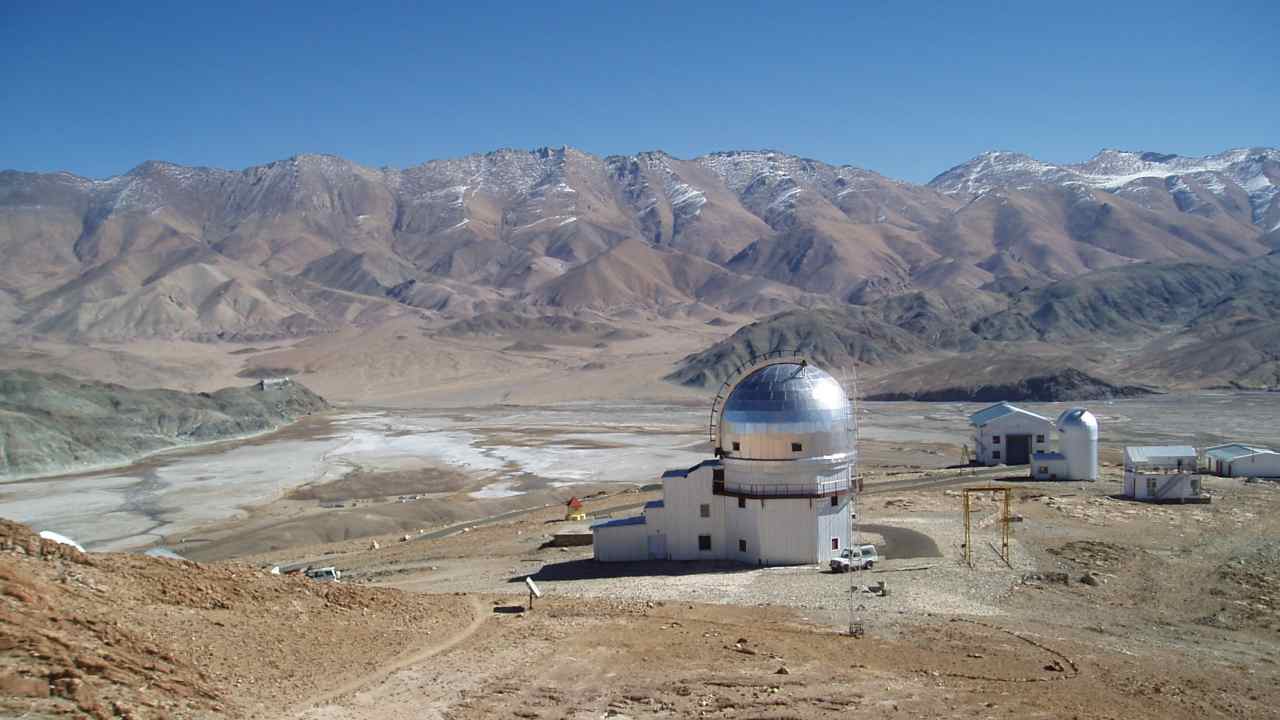Indian astronomers would soon be able to observe and monitor spectacular celestial events like
explosion of stars
, falling of matter into
black holes
and collision of extraterrestrial objects better. Researchers at Tata Institute of Fundamental Research and Bhabha Atomic Research Centre are developing a new
gamma ray telescope
in Ladakh. The four-metre telescope will be able to operate in bright environment like twilight hours and moon-lit nights, unlike traditional ones that operate only in dark hours of the night. It will be the second such telescope to be available globally. The first one is in
La Palma
in Canary Islands set up jointly by Switzerland and Germany in 2011. A view of upcoming MACE telescope next to the
Hagar array at Hanle
in Ladakh. The new 4-meter telescope will also be installed in this area. Speaking to India Science Wire, Dr Varsha Chitnis of Department of
High-energy Physics
at TIFR, said the imaging camera to be used in the telescope is different from convention ones. It used pixels made of what are called Geiger-mode avalanche photo-diodes (G-APDs), while conventional telescope cameras are based on photomultiplier tubes (PMTs). “G-APDs need a much lower operation voltage, are more robust and have higher photon detection efficiency. They can be operated during strong moon light and are ideal for a gamma ray telescope,” she added. [caption id=“attachment_5230601” align=“alignnone” width=“1280”] Part of the Hanle gamma ray observatory in Ladakh. Image courtesy: TravelDham[/caption] The new telescope will be located near the High-altitude Gamma Ray (HAGAR) array at Hanle in Ladakh which houses the
Indian Astronomical Observatory
operated by Indian Institute of Astrophysics, Bengaluru. It will work in tandem with MACE (Major Atmospheric Cerenkov Experiment) — a 21-metre diameter gamma ray imaging telescope which is also under installation at Hanle. While MACE will operate in discovery mode looking at candidate sources of gamma ray or very faint objects, the new telescope will keep an eye on
blazars
. Whenever there is any flaring activity in any of them, it will alert MACE which will then shift its focus to the
active blazer
. Gamma rays provide the best window to study what are called the non-thermal universe.
Cosmic rays
form an important component of the non-thermal universe. It is thought that remnants of
supernova explosions
accelerate cosmic rays with energies at the lower end of the cosmic ray spectrum and that higher energy cosmic rays could be accelerated in active galactic nuclei. Gamma rays are also produced when charged particles are accelerated to such high energies through different processes. Thus, the study of the gamma ray emissions from various celestial objects is expected to give a clue regarding the origin of cosmic rays and insights into the emission regions and emission processes in these sources. The details of the new telescope have been discussed in a
recent paper
published in Journal of Astrophysics and Astronomy.
Part of the Hanle gamma ray observatory in Ladakh. Image courtesy: TravelDham[/caption] The new telescope will be located near the High-altitude Gamma Ray (HAGAR) array at Hanle in Ladakh which houses the
Indian Astronomical Observatory
operated by Indian Institute of Astrophysics, Bengaluru. It will work in tandem with MACE (Major Atmospheric Cerenkov Experiment) — a 21-metre diameter gamma ray imaging telescope which is also under installation at Hanle. While MACE will operate in discovery mode looking at candidate sources of gamma ray or very faint objects, the new telescope will keep an eye on
blazars
. Whenever there is any flaring activity in any of them, it will alert MACE which will then shift its focus to the
active blazer
. Gamma rays provide the best window to study what are called the non-thermal universe.
Cosmic rays
form an important component of the non-thermal universe. It is thought that remnants of
supernova explosions
accelerate cosmic rays with energies at the lower end of the cosmic ray spectrum and that higher energy cosmic rays could be accelerated in active galactic nuclei. Gamma rays are also produced when charged particles are accelerated to such high energies through different processes. Thus, the study of the gamma ray emissions from various celestial objects is expected to give a clue regarding the origin of cosmic rays and insights into the emission regions and emission processes in these sources. The details of the new telescope have been discussed in a
recent paper
published in Journal of Astrophysics and Astronomy.
New gamma ray telescope coming up in Ladakh to observe exploding stars, black holes
India Science Wire
• September 21, 2018, 09:16:25 IST
The telescope will the second in the world to function in both, bright and moon-lit environments.
Advertisement
)
End of Article